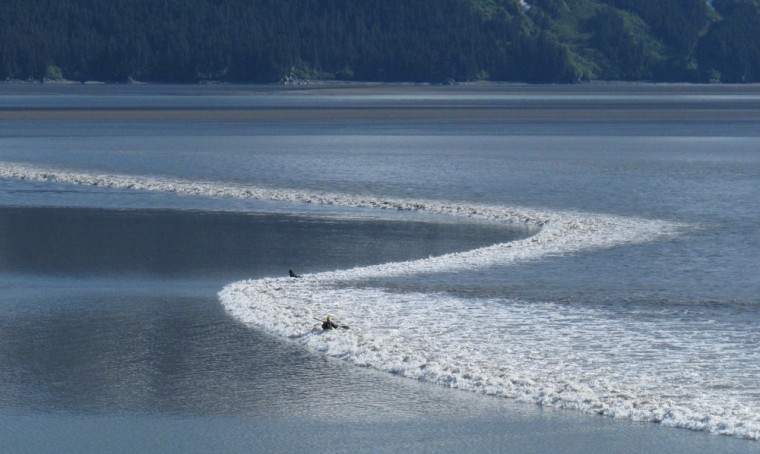Mother Nature put on a show near Anchorage, and it had nothing to do with Venus and the sun.
The largest bore tide of the summer arrived in Turnagain Arm on Tuesday evening, drawing hundreds of people to highway pullouts south of Anchorage.
It also drew a few surfers and kayakers hoping to take advantage of a real wave in Alaska.
"It was fantastic," said surfer Sue Ives of Anchorage. "It was a bluebird day. The water was glassy. I guess this is supposed to be the biggest bore tide of the year, so it was a pretty great ride."
The bore tide is an actual tidal wave, said Michael Lawson, a meteorologist with the National Weather Service in Anchorage.
"The bore tide is a true tidal wave in the sense that it's controlled by the tide and is largely due to the gravitational influence of the sun and moon."
Bore tides happen all over the world, but Anchorage's Turnagain Arm and Knik Arms are the only places in the United States where they occur regularly, he said.
That's due to the orientation of Turnagain Arm and the shallow, narrow terrain along the strip of water stretching about 25 miles from Anchorage south to the resort town of Girdwood.
Bore tides happen every day here, Lawson said, but whether there's a visible wave associated with it depends on the weather and the exact nature of the tides.
"One thing that makes this a predictably large bore tide is that we just had a full moon, and right now, the moon and the sun are in alignment," Lawson said.
Lawson said those gravitational forces work to pull the tide extremely negatively below what the average mean water level is at low tide.
"When the tide goes all the way out, the tide further up the arm is still going to be coming out when the new tide is coming in, and where those two bodies of water clash is where the wave is created," he said.
Local media had been alerting residents to the pending large bore tide since Monday.
"Today, everybody is telling us about it on the radio cause it's supposed to be a big bore tide, so we're hoping it's 35 inches," said Anchorage resident Ellen Franklin. "That would be awesome."
There was no immediate measurement of the bore tide. The National Weather Service doesn't track it, but the state Department of Natural Resources earlier this week predicted it could be 4.1 feet.
Nearly every space and places that weren't meant for parked cars were filled along the pullouts along the scenic Seward Highway. People brought lawn chairs, binoculars and cameras for the event.
Some climbed down the rocky beaches to outlying rocks for better viewing. That caused at least one problem, KTUU reported that three men became trapped on rocks after the tide came in and had to be rescued by a boat manned by the Anchorage Fire Department, which said the men were in no danger.
Several others, like Ives, donned their wet suits and tried to catch the wave.
Ives estimated her ride on the wave went anywhere from a quarter- to a half-mile.
"A nice long ride, long enough that my legs started to feel a little tired," she said.
She also wasn't bummed that this is apparently the largest bore tide of the summer, and plans to surf again.
"It just means that maybe next time there'll be fewer people out here, and it will be nice and quiet," she said.
